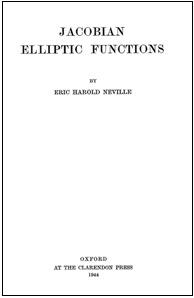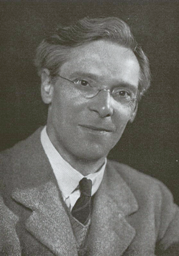 The website is in construction. New files will be uploaded as soon as they are available.
The website is in construction. New files will be uploaded as soon as they are available.
ERIC HAROLD NEVILLE
London 1889 - Reading 1961

- Brief scientific biography
- Neville's work in mathematical education
- Essential bibliography
- Articles on the teaching of mathematics
Brief scientific biography
Eric Harold Neville was born in London on 1 January 1889. Attending the William Ellis School, his mathematical abilities were recognised and encouraged by his mathematics teacher, T. P. Nunn. In 1907, he entered Trinity College, Cambridge, graduating as second wrangler two years later, and subsequently winning a Trinity fellowship. While there he became acquainted with other Cambridge fellows, most notably Bertrand Russell and G. H. Hardy.
The story of Hardy and his Indian protégé Srinivasa Ramanujan is one of the most famous in the history of modern mathematics. But Neville's role in it is less well known. In 1914, as a visiting lecturer, he travelled to India, where, in response to a request from Hardy, he managed to persuade the cautious Ramanujan to accompany him back to England, thus playing a vital role in the initiation of one of the most celebrated mathematical collaborations of the last hundred years.

Despite being eligible to serve during the First World War, Neville did not join the army when hostilities erupted in the summer of 1914. Although poor eyesight would have prevented him from active service, he openly declared his opposition to the conflict and refused to fight. While no reason was ever given, it was probably this pacifist declaration that resulted in the non-renewal of his Trinity fellowship in 1919. On leaving Cambridge, he was appointed to the chair of mathematics at the small University College, Reading. In a few years, he had built up the mathematics department there, working vigorously to enable the institution to receive a university charter and award its own degrees from 1926.
Neville had a wide variety of mathematical interests, but his principal areas of expertise were geometrical, with differential geometry dominating much of his early work. Early on in his Trinity fellowship, in a dissertation on moving axes, he extended Darboux's method of the moving triad and coefficients of spin by removing the restriction of the orthogonal frame. He later wrote an introductory tract on how to generalise concepts and operations of 3-space into the four-dimensional arena. But his ambition to write a comprehensive treatise on differential geometry was never realised.
During his time in Cambridge, he had been greatly influenced by Bertrand Russell's work on the logical foundations of mathematics and in 1922 he published his Prolegomena to analytical geometry prompted by the absence, in his view, of adequate foundational treatments of the topic. Highly influenced by Russell's work, it is a detailed and logical investigation of the foundations of analytical geometry, providing an axiomatic development of the subject.
Neville had long held a keen interest in elliptic functions, having taught the subject to postgraduate students at Reading since the 1920s. He believed that the subject's recent decline in popularity was due to its dependence on a mass of complicated formulae, a variety of differing and confusing notations, and an artificial definition relying on a familiarity with theta functions. A period of recuperation from an illness in 1940 gave him the opportunity to put several years of lecture notes into publishable form. The result was his best-known, and perhaps most original, work: Jacobian elliptic functions (1944).
By starting with the Weierstrass P-function and associating with it a group of doubly-periodic functions with two simple poles, he was able to give a simple derivation of the Jacobian elliptic functions, as well as modifying the existing notation to provide a more systematic approach to the subject. Like all of Neville's books, Jacobian elliptic functions, while intricate and not easy to read, is expertly crafted and painstakingly thorough. Unfortunately, it failed to achieve its author's stated intention "to restore the Jacobian functions to the elementary curriculum" (NEVILLE 1951, vi) and its appearance came too late to have any real effect on the dominance of the classical approach to elliptic functions.
Neville was an active member of several mathematical and scientific bodies. Elected to membership of the London Mathematical Society in 1913, he served on its council from 1926 to 1931. He regularly attended meetings of the British Association for the Advancement of Science, being President of Section A (Mathematics and Physics) in 1950. He also chaired its Mathematical Tables Committee from 1931 to 1947 and, when it came under the auspices of the Royal Society, he contributed two sets of tables, on Farey series of order 1025 (1950) and Rectangular-polar conversion tables (1956).
Neville published many papers, but the vast majority were short items, focusing on concise and succinctly-solved problems, often in the Mathematical Gazette, to which he was a frequent contributor. As with all of his writings, they were focused and highly polished, yet, as one obituary says with regret, "so brilliant and versatile a talent could have been harnessed to some major mathematical investigation" (BROADBENT 1962, 482). Indeed, a former student at Reading could "never understand why his published work of substance was so small in quantity" (LANGFORD 1964, 133).
Neville retired from the University of Reading in 1954, after which he continued to publish papers in the Mathematical Gazette. He was working on a sequel to his book on elliptic functions when he died on 22 August 1961.
Neville's work in mathematical education
Neville's work in mathematical education manifested itself in three main forums: his teaching at the University of Reading; his work for the Mathematical Association; and his membership of the Executive Committee of ICMI.By all accounts, in his lectures at Reading, Neville was a skillful and considerate teacher, possessing a "unique gift of handling problems with superb technical skill and economy" (LANGFORD 1964, 132). From the perspective of one of his students from the 1920s, "as a teacher he was an inspiring guide (though sometimes so far ahead as to be almost out of sight) but with the small classes of those days-there were never more than three of us in the honours group-a lecture could always become a seminar if we wished, and he delighted in the arguments which could develop" (LANGFORD 1964, 134). However, according to one of his colleagues at Reading, the sharpness of his mind and the depth of his knowledge could often leave the less able students feeling rather baffled:
Honours students were inspired by the brilliance of his lectures and the immensity of his erudition; and if the pass degree pupils sometimes found him above their heads, this was never from any failure of his sympathy, but because he could often modestly forget how fast his own mind worked (BROADBENT 1962, 479)

Introduced to its activities by his former teacher, T. P. Nunn, in 1922 he chaired a sub-committee of the Association's General Teaching Committee charged with reporting on the teaching of geometry in British schools. The resulting report recommended dividing school geometry into stages: experimental, deductive, systematising, and advanced. Later described as "revolutionary", one committee member later wrote: "It is perhaps not giving away a secret to say that T.P.N. and E.H.N. were the two principally responsible for the Report, which has been a best-seller ever since" (BROADBENT 1964, 137).
His involvement with the Association's chief publication, The Mathematical Gazette, began while he was still at Cambridge. For over four decades, Neville contributed a multitude of articles, classroom notes and book reviews on a wide variety of mathematical topics. He also briefly edited the journal in the late 1920s, following the illness and death of the then editor, until a replacement was appointed. He was the Association's Librarian for over thirty years, from 1923 to 1954, and served as its President in 1934.
His presidential address, "The Food of the Gods", drew attention to the widening gap between school and university mathematics. He began by noting that, in the quarter-century since he took his degree, British university mathematics courses had grown considerably, featuring subjects (such as matrices, vectors, Lebesgue integration, tensor calculus, statistics, relativity and wave mechanics) that were all but unknown to British undergraduates 25 years before. His central argument was that "the university builds a different mathematical structure, but is content to build it on foundations which have not changed since the beginning of the century" (NEVILLE 1935, 7). He continued:
The burden of my plea this afternoon is that changes in emphasis in creative mathematics, which have now a direct influence on teaching at the university, ought to have a greater and a far more rapid influence on teaching at the school than they seem to have. (NEVILLE 1935, 16)It was his opinion that, while the more experienced teachers have greater authority and influence, it is younger teachers who are more in touch with what will best equip a student for university studies.
Twenty years ago we did know what were the best current methods of presentation, where emphasis had to be placed to serve most efficiently the needs of those who were soon to be undergraduate students of mathematics. How many of us who are engaged in teaching rather than research can make the same boast to-day? (NEVILLE 1935, 16)Urging his colleagues to consider changes to the secondary school curriculum, he asked:
Is it absolutely certain that the [school] curriculum is perfect, that there is nothing which could be postponed in favour of some subject now acquired at a later stage? Is it quite indisputable that none of the teaching is wasteful, that nowhere would better methods enable us to explain in one hour a principle over which we have got into the habit of spending two? (NEVILLE 1935, 7)The theme is as pertinent today as when it was delivered in 1935.
Neville's work for the Mathematical Association and British mathematical education generally brought him recognition from overseas. The high regard in which he was held by the British pedagogical community was reflected in his election in 1932 as a member of the Central Committee of ICMI, on which he served with Hadamard as President and Fehr as Secretary General. He was re-elected in 1936.
Essential bibliography
E.H. NEVILLE 1921, Multilinear functions of direction, and their uses in differential geometry, Cambridge, Cambridge University Press
E.H. NEVILLE 1921, The fourth dimension, Cambridge, Cambridge University Press
E.H. NEVILLE 1922, Prolegomena to analytical geometry in anisotropic Euclidean space of three dimensions, Cambridge, Cambridge University Press
E.H. NEVILLE 1944, Jacobian elliptic functions, Oxford, Clarendon Press, Second edition, 1951
E.H. NEVILLE 1950, The Farey series of order 1025. Displaying solutions of the Diophantine equation
by - ax = 1, Cambridge, Cambridge University Press
E.H. NEVILLE 1956, Rectangular-polar conversion tables, Cambridge, Cambridge University Press
T. A. A. BROADBENT 1962, Eric Harold Neville, Journal of the London Mathematical Society, 37, 479-482
T. A. A. BROADBENT 1964, On the Teaching Committee, The Mathematical Gazette, 48, 136-139
W. J. LANGFORD 1964, Professor Eric Harold Neville, M.A., B.Sc.: The man, The Mathematical Gazette, 48, 131-136
Articles on the teaching of mathematics
E.H. NEVILLE 1919, Notes for lessons introductory to differential geometry, The Mathematical Gazette, 9, 369-371
E.H. NEVILLE 1930, Higher trigonometry for schools, The Mathematical Gazette, 15, 180
E.H. NEVILLE 1933, The teaching of geometry, The Mathematical Gazette, 17, 307-312
E.H. NEVILLE 1935, The food of the gods, The Mathematical Gazette, 19, 5-17
E.H. NEVILLE 1937, The influence of the university on school geometry, The Mathematical Gazette, 21, 339-343
E.H. NEVILLE 1964, Mathematical notation, The Mathematical Gazette, 48, 145-163
Author
Adrian Rice
Randolph-Macon College, Ashland, Virginia
arice4@rmc.edu
